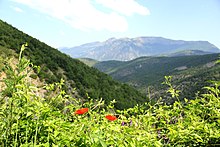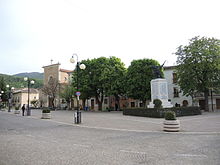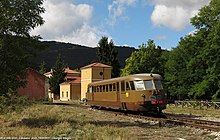|
Cansano
Cansano (pronounced [kanˈsaːno]; Canẓánə in Abruzzese Neapolitan[3]) is a comune in the province of L'Aquila in the Abruzzo region, Southern Italy. It is part of the Maiella National Park.[4] Cansano is known for the archaeological discovery of the Italic and Roman town of Ocriticum, which has become an archaeological park.[5] Geography and climate Cansano is located 9 km (5.6 mi) from Sulmona, on a hill near the Valle Peligna, at 835 m (2,740 ft) m above sea level.[6] The minimum altitude of the municipality of Cansano is 599 m (1,965 ft), while the maximum is 1,792 m (5,879 ft).[7] The area of the municipal territory is 37.70 km2 (14.56 sq mi).[7] The town is part of an almost intact natural landscape. Part of the Maiella National Park is part of the town, and in particular, the Sant'Antonio wood and the San Leonardo pass. The position also favors travel to the most active tourist centers in the area; Campo di Giove, Pacentro, Pescocostanzo and Sulmona. The town has a mountain climate,[6] with hot, dry summers and cold, rainy winters. However, over time there have been variations in the climate, which is now slightly more humid in summer and less snowy in winter. History Built as a fiefdom and watchtower in the early Middle Ages,[8] it spread mainly between the 19th and 20th centuries, following the 1706 Abruzzo earthquake. In 1904, Casano became an independent municipality.[9] From 1807 to 1811, Cansano was a frazione of Introdacqua, then from that year until 1829 it was a frazione of Pacentro.[10] It obtained municipal autonomy until 1846, when it was re-aggregated in Pacentro until 1855.[10] Cansano become a frazione of Campo di Giove from 1855 to 1904, when it definitively regained municipal autonomy.[10] Main sights Sights include:
Demographics
 The demographic history of Cansano is one of the most striking examples of the Italian diaspora, given that its population, starting from the first post-war period, went from just over 1,500 people to the 282 registered in 2014.[12] The emigrants from Cansano mainly went to Canada, the United States, South America and, to a lesser extent, to Australia, New Zealand and Northern Europe.[12] The most common surnames in Cansano are, in descending order of diffusion, Ruscitti, De Santis, Di Paolo, Di Silvio and Di Cesare.[7] Culture MuseumsIn Piazza XX Settembre there is the Ocriticum documentation center, inaugurated in 2004,[13] which also contains a permanent exhibition on the emigration of the inhabitants from Cansano,[14] as well as ex-voto objects found in the Ocriticum archaeological park.[5] CuisineThe cuisine of Cansano makes use of local agricultural and livestock products, such as various legumes, lamb and goat meat, pecorino cheese, smoked prosciutto[15] and goat ricotta, and the surrounding area, such as mushrooms, mercury goosefoot and truffles.[16] As for legumes, chickpeas are used as a condiment in pasta or pastora soup; other first courses are gnocchi with mutton ragout, maccheroni alla chitarra, spienaturo polenta, cooked in winter, and ravioli with ricotta.[16] The wild vegetables of the area are used as an ingredient in recipes such as pizza and fuij, and pancotto.[16] Among the desserts, there are sweet pizza and pizzelle.[16] Transportation The Cansano railway station is located along the Sulmona-Isernia railway, currently in use only as a heritage railway.[17] In the past, the line guaranteed regular connections with Sulmona, Isernia, L'Aquila, Rome, Pescara and Naples,[18] but the ordinary service was suspended on 11 December 2011.[19] The reopening as a heritage railway took place on 17 May 2014,[20] but the Cansano station, suppressed in December 2002,[21] had to wait until 16 July 2017 for its restoration.[22] Along the same line, as of 2023, a second railway station is under construction in the municipal area of Cansano, the Ocriticum station, serving the Ocriticum archaeological park.[23] SportThe only sports association present is the "ASD Majella United" football team, which played in regional amateur championships, born in 2018 from the merger of the previous company "ASD Cansano" with that of "ASD Campo di Giove", from the town of the same name on the slopes of the Maiella bordering Cansano.[24] See alsoReferences
External linksWikimedia Commons has media related to Cansano.
|
||||||||||||||||||||||||||||||||||||||||||||||||||||||||||||||||||||||||||||||||||||||||||||||||||||||||||||||||||




